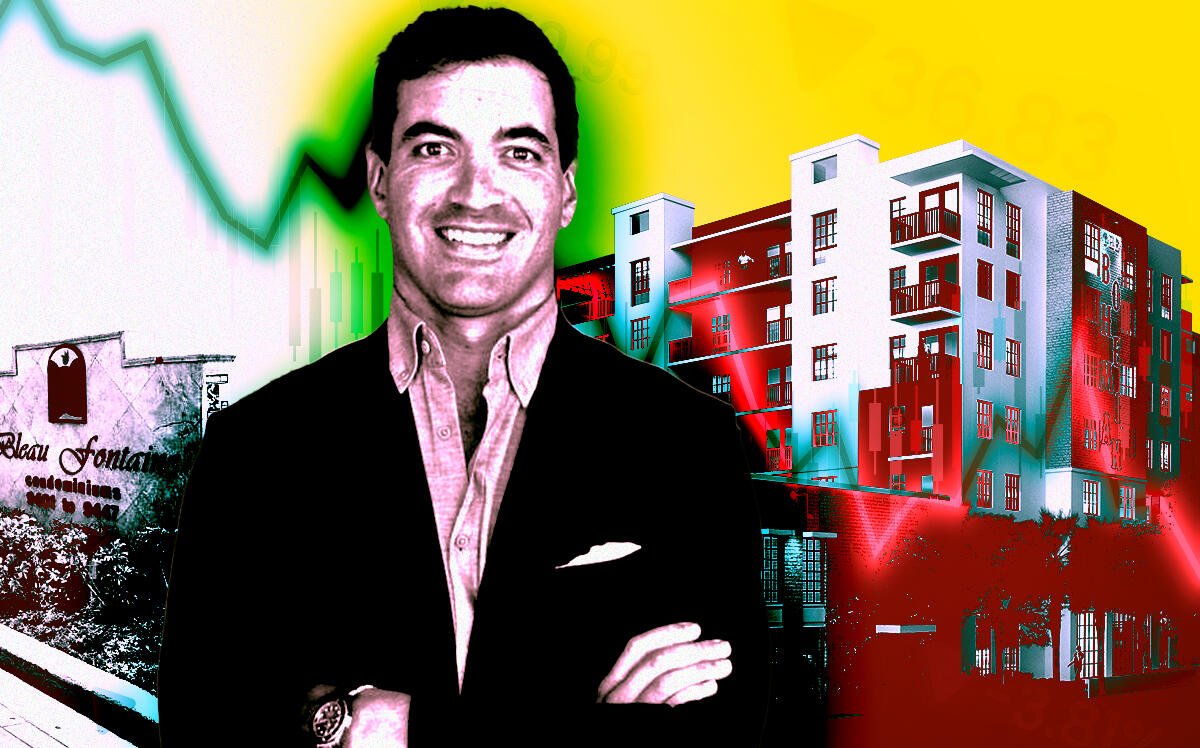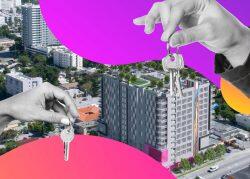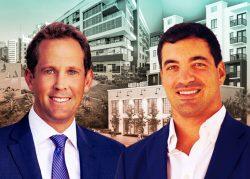 Citadel migration continues: Exec buys Pinecrest home for 91% markup
Citadel migration continues: Exec buys Pinecrest home for 91% markup
Trending
“Slamming on the brakes”: South Florida’s record rent hikes slow
In the most aggressive predictions, some academics say rents will stay flat or even slightly drop. Is out-migration the reason?

Apartment broker Carlos Larocca’s phone is buzzing much less often than a year ago.
Not only has interest waned in the South Beach building he leases, but monthly rents — now close to $1,800 for a one-bedroom unit, up from $1,000 in spring 2020 — likely won’t increase anymore, he said.

The Keyes Company’s Carlos Larocca (The Keyes Company)
“I think we have reached a plateau,” said Larocca, of The Keyes Company.
The “plateau” is not just at the two-story cream yellow Jefferson Avenue building Larocca leases. South Florida – which has led the nation in rent hikes for the past two years – is in for a break, according to experts and data.
At first, the signs were easy to overlook. Annual South Florida median rent increases dropped to 52 percent in April from 57 percent in March, Realtor.com reports show. By now, the reprieve has crystallized. The May year-over-year median increase declined to 46 percent. In June, 37 percent.
Further market calming is in store, experts say. South Florida is in line for a traditional increase of 5 percent to 10 percent in the next year, with some predicting flat rents or even a drop of a few hundred dollars, though not to the low levels of 2019.
“You can see we are just slamming on the brakes,” said Ken Johnson, a Florida Atlantic University professor and economist.
He is part of the team that put together the Waller, Weeks and Johnson Rental Index, which shows South Florida’s average rent rose 0.35 percent in July, Johnson said. That rate, which annualizes to 4 percent, is less than the 0.5 percent average increase in June, which annualizes to 6 percent.
What exactly is causing the reprieve is somewhat unclear. As inventory still is not catching up to demand, theories abound that some of the hunger for apartments has dwindled due to out-migration.
Or, maybe, South Florida’s cost-overburdened housing market reached a breaking point.
“Here’s my take,” said Enrique Teran, president of the residential board at the Miami Association of Realtors. “Something’s always got to give somewhere.”
Bye, bye Miami
Scores of transplants arrived in South Florida following its early reopening from the pandemic lockdown in 2020, and basked in the lack of a state income tax. Rent hikes ensued, and locals felt the strain.
Local salaries have long lagged behind those of other metropolises, better allowing newcomers who kept their out-of-state jobs to afford apartments. (This year, Miami-Dade County’s median income is $68,300, while New York’s is $94,500 and Los Angeles County’s is $91,100, according to the Department of Housing and Urban Development.)

Miami Association of Realtors’ Enrique Teran (Avanti Way)
Some locals just gave up on Miami, Teran said. At Avanti Way Realty’s Orlando office, 60 percent to 70 percent of apartment interest is from South Floridians, said Teran, co-founder of the development and brokerage firm.
“You would see that type of person that just gets priced out, and tells you, ‘I couldn’t afford Miami. I had to leave,’” he said.
Sunshine State markets outside of South Florida also have experienced skyrocketing rents. But Orlando’s $2,000 June median rent, as well as Tampa’s $2,100 and Jacksonville’s $1,600, still remain below Miami’s $2,800, Realtor.com data shows.
At Avanti’s 127-unit apartment project near Universal Studios, a newly built two-bedroom unit rents for $2,350 a month. But at the Bleau Fontaine community in Miami-Dade’s Fontainebleau neighborhood, it’s roughly $2,700 a month for the same sized unit, said Teran, whose Avanti manages part of the complex. And that’s for a community built decades ago.
Elliot Machado, a broker with One Sotheby’s International Realty, said that as the market stabilizes, landlords need to change their pricing strategy. Rather than setting asking rents higher and higher, he said landlords should price more reasonably to drum up interest and avoid units sitting on the market for too long.
“Let’s price right to get multiple candidates,” he said.
Teran argues that the changing regional demographics in favor of “more affluent” residents spurs economic growth.
South Florida is attracting such firms as Ken Griffin’s Citadel, which is moving its headquarters to Brickell from Chicago, as well as its well-heeled executives.
Meanwhile, amid relocations and expansions, West Palm Beach has earned the moniker of “Wall Street of the South” as a mecca for financial firms. Miami’s Wynwood is sometimes referred to as the “Silicon Valley of the South” for becoming a choice for tech firms.
Read more
 Citadel migration continues: Exec buys Pinecrest home for 91% markup
Citadel migration continues: Exec buys Pinecrest home for 91% markup
 CI Financial doubles down on U.S. HQ lease at 830 Brickell in Miami
CI Financial doubles down on U.S. HQ lease at 830 Brickell in Miami
 South Florida apartment crunch: Locals squeezed out, as demand from newcomers leads to record rents
South Florida apartment crunch: Locals squeezed out, as demand from newcomers leads to record rents
Yet, some say that potentially squeezing out locals is not the way to create a true economic boost. “Fairly soon, there won’t be bank tellers, firemen, police officers, which is going to hurt the services in the local area,” said Johnson, the FAU economist.
Still, he argues that recent transplants are now bidding goodbye to Miami, as many are being called back to the office in the states where their jobs are located.
Miami-Dade County’s population is expected to grow by 4.6 percent over the next 10 years, according to StatsAmerica, provided by Indiana University’s Kelley School of Business’ Indiana Business Research Center.

Florida Atlantic University’s Ken Johnson (FAU)
That’s still less than the 8 percent to 10 percent projections Johnson said StatsAmerica showed in recent years.
The slowdown in population influx has eased demand for rentals.
“There’s not enough demand for it to keep going up. People are kind of done,” said agent Jaclyn Bild of Douglas Elliman, adding that this has allowed for rent negotiation.
Machado said the dissipating frenzy can be chalked up to reduced “renter desperation.”
All this, Johnson said, amounts to a calming of rent growth — yet, an unrelenting affordability crisis.
The issue: A housing shortage exacerbated by the loss of units to short-term rentals such as Airbnb and Vrbo, Johnson said. The solution: Simply build more, he said, taking issue with NIMBY sentiments.
“We want this evolution of the economy to happen,” he said. “But we could be our own worst enemies if we don’t allow for development.”
Build, baby, build
More than 15,000 apartments are slated to be completed by year-end, with absorption projected to be close to 7,000 units, according to Berkadia’s mid-year multifamily report. By the end of 2024, the region is in line to get over 29,000 new apartments.
This would alleviate the rent strain felt last year when 13,000 completed units barely made a dent in 30,600 absorbed apartments, the report shows.
Although the majority of new construction is in Miami and Fort Lauderdale, areas long glossed over by developers have seen construction cranes grace their skylines.
Since these pockets are off-the-beaten path, they also offer somewhat lower rents.
In Lake Worth Beach, Affiliated Development’s recently completed 200-unit Bohemian offers one-bedroom apartments for $1,800 a month, said Nick Rojo, co-founder of Affiliated. That’s less than South Florida’s $2,500 median one-bedroom rent that Realtor.com reported for June.
Read more
 Estate Companies’ Pompano Beach, Hollywood apartment projects advance
Estate Companies’ Pompano Beach, Hollywood apartment projects advance
 Public housing goes middle class
Public housing goes middle class
Developers are unfazed by slowed rent growth, as their project proformas are based on traditional increases such as 6 percent, even in times when rates escalate much more than that, sources said.
What could faze builders is the slew of government initiatives aimed at helping tenants, Teran said, arguing this will only thwart development needed to alleviate rent hikes.
Miami-Dade, considered the epicenter of the national housing crisis, requires a 60-day notice for a rent hike of 5 percent or more, as well as eviction notices. The county also could follow Orlando, which is holding a rent-control referendum, aimed at capping rents for a year.
Instead, incomes should rise and governments should incentivize building, Teran said.
“Somewhere along those lines is that bliss point,” he said.




